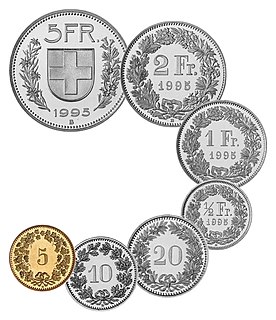
The Swiss franc is the currency and legal tender of Switzerland and Liechtenstein. It is also legal tender in the Italian exclave of Campione d'Italia. The Swiss National Bank (SNB) issues banknotes and the federal mint Swissmint issues coins.

The franc, also commonly distinguished as the French franc (FF), was a currency of France. Between 1360 and 1641, it was the name of coins worth 1 livre tournois and it remained in common parlance as a term for this amount of money. It was reintroduced in 1795. After two centuries of inflation, it was revalued in 1960, with each new franc (NF) being worth 100 old francs. The NF designation was continued for a few years before the currency returned to being simply the franc; some mostly older French residents continued to reference and value items in terms of the old franc until the introduction of the euro in 2002. The French franc was a commonly held international reserve currency of reference in the 19th and 20th centuries.

The solidus, nomisma, or bezant was originally a relatively pure gold coin issued in the Late Roman Empire. Under Constantine, who introduced it on a wide scale, it had a weight of about 4.5 grams. It was largely replaced in Western Europe by Pepin the Short's currency reform, which introduced the silver-based pound/shilling/penny system, under which the shilling functioned as a unit of account equivalent to 12 pence, eventually developing into the French sou. In Eastern Europe, the nomisma was gradually debased by the Byzantine emperors until it was abolished by Alexius I in 1092, who replaced it with the hyperpyron, which also came to be known as a "bezant". The Byzantine solidus also inspired the originally slightly less pure dinar issued by the Muslim Caliphate.
The livre tournois, French for the "Tours pound", was one of numerous currencies used in France in the Middle Ages, and a unit of account used in Early Modern France.

The pound is the currency of Guernsey. Since 1921, Guernsey has been in currency union with the United Kingdom and the Guernsey pound is not a separate currency but is a local issue of banknotes and coins denominated in pound sterling, in a similar way to the banknotes issued in Scotland, England and Northern Ireland. It can be exchanged at par with other sterling coinage and notes.
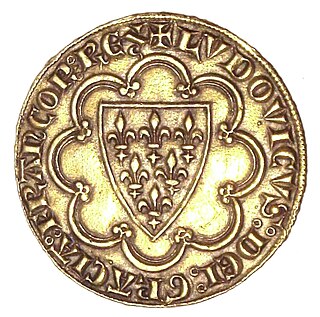
The term écu or crown may refer to one of several French coins. The first écu was a gold coin minted during the reign of Louis IX of France, in 1266. Écu means shield, and the coin was so called because its design included the coat of arms of France. The word is related to scudo and escudo. The value of the écu varied considerably over time, and silver coins were also introduced.
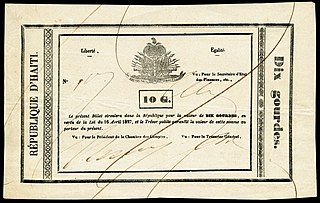
The gourde or goud is the currency of Haiti. Its ISO 4217 code is HTG and it is divided into 100 centimes (French) or santim (Creole).
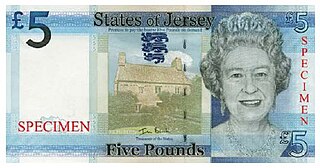
The pound is the currency of Jersey. Jersey is in currency union with the United Kingdom, and the Jersey pound is not a separate currency but is an issue of banknotes and coins by the States of Jersey denominated in pound sterling, in a similar way to the banknotes issued in Scotland and Northern Ireland. It can be exchanged at par with other sterling coinage and notes.

The Djiboutian franc is the currency of Djibouti. Its ISO 4217 currency code is DJF. Historically, it was subdivided into 100 centimes.
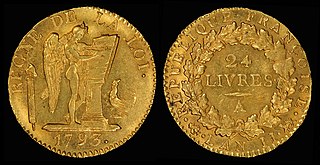
The livre was the currency of Kingdom of France and its predecessor state of West Francia from 781 to 1794. Several different livres existed, some concurrently. The livre was the name of both units of account and coins.

Canada has an extensive history with regard to its currencies. Prior to European contact, indigenous peoples in Canada used items such as wampum and furs for trading purposes, which continued when trade with Europeans began.
The franc was the currency of Réunion until 1999. Before 1975, Réunion had its own franc, distinct from that of France. After 1975, the French franc circulated. Réunion now uses the euro. The Réunion franc was subdivided into 100 centimes.
The history of currency in the British colony of St. Kitts closely follows that of the British Eastern Caribbean territories in general. Even though Queen Anne's proclamation of 1704 brought the gold standard to the West Indies, silver pieces of eight continued to form a major portion of the circulating currency right into the latter half of the nineteenth century.
The Geneva thaler was a coin equivalent to the French silver écu, containing 26.67 g fine silver and valued at 123⁄4florins, which was issued by Geneva until 1798 and between 1813 and 1839.
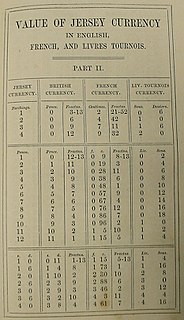
The livre was currency of Jersey until 1834. It consisted entirely of French coins.

The coinage of Philip IV of France marks the first mass diffusion of gold coinage in the Kingdom of France. Philip however had to resort extensively to monetary devaluations and reevaluations in order to finance his royal budget as well as his war efforts.

Fiat money is a currency established as money, often by government regulation. Fiat money does not have intrinsic value and does not have use value. It has value only because a government maintains its value, or because parties engaging in exchange agree on its value. It was introduced as an alternative to commodity money and representative money. Representative money is similar to fiat money, but it represents a claim on a commodity.
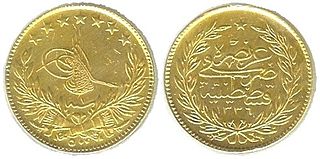
The Ottoman lira was the currency of Ottoman Empire between 1844 and 29 October 1923 when it was replaced by the Turkish lira. The Ottoman lira remained in circulation until the end of 1927.

Card money was in use in New France in the seventeenth and eighteenth centuries. Official money cards were embossed with a fleur-de-lis and the signatures of the intendant, governor, and treasurer. Private cards would also use the fleur-de-lis and the signature of its debtor. Card money was generally issued, at least initially, in emergency situations when minted currency was in low supply, however overtime "playing cards" became more popular and the standard tender. An estimated two million livres in card money is thought to have circulated prior to the British take over of New France territory in the 1760s.

Card money is a type of fiat money printed on plain cardboard or playing cards, which was used at times as currency in several colonies and countries from the 17th century to the early 19th century. Where introduced, it was often followed by high rates of inflation.
















